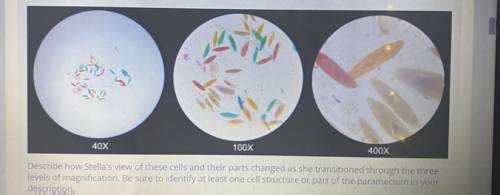
Biology, 25.01.2021 23:00 apowers6361
Describe how stellas view of these cells and their parts changed as she transitioned through the three levels of magnification. Be sure to identify at least one cell structure or part of the paramecium in ur answer.


Answers: 2
Another question on Biology

Biology, 22.06.2019 00:30
Compare and contrast cladistics and phylogeny. what are their advantages and disadvantages? which is the most useful in understanding how an organism developed into its current form? which concept most strongly supports your opinion about the origin of any given organism?
Answers: 1

Biology, 22.06.2019 01:00
The sketch shows a rynchosaur, an extinct animal that is known only from fossils. there has been much debate about the classification of these creatures. some scientists suggest that they belong with primitive amphibians, and some think they are related to snakes and lizards.the data equally support both cases. which statement best explains how to draw a cladogram that includes the rynchosaur? draw the cladogram for amphibians. draw the cladogram for reptiles. draw two cladograms, both showing the traits, and leave it as a hypothesis. draw two cladograms, both showing the traits, and have scientists vote
Answers: 2

Biology, 22.06.2019 04:30
Which would be the most useful source of evidence to support mcneill's contention?
Answers: 3

Biology, 22.06.2019 06:50
The kidney filters potentially toxic substances in the blood, and thus “clears” the blood of those substances. this clearance function is dependent upon and proportional to the diffusion gradient of the substance across filtering capillaries, i.e. if the concentration of the substance is doubled, twice as much will be cleared from each ml of blood that is filtered. suppose that the body produces a constant amount of a substance x per unit of time. the kidneys eliminate substance x at a rate directly proportional to the concentration of the substance and the volume of blood cleared each minute (c): elimination = c × [x], where [x] is the steady-state concentration of substance x. imagine an individual with an initial concentration of x equal to [x]0 who develops kidney disease. her baseline clearance c0 drops to one half of the original (½c0). what is the new steady state concentration of x? (for simplicity, assume that substance x is 100% filtered by the kidney).
Answers: 1
You know the right answer?
Describe how stellas view of these cells and their parts changed as she transitioned through the thr...
Questions

Mathematics, 01.09.2020 04:01


Engineering, 01.09.2020 04:01





Mathematics, 01.09.2020 04:01

Geography, 01.09.2020 04:01



Mathematics, 01.09.2020 04:01

English, 01.09.2020 04:01


Mathematics, 01.09.2020 04:01

English, 01.09.2020 04:01



English, 01.09.2020 04:01

Advanced Placement (AP), 01.09.2020 04:01



